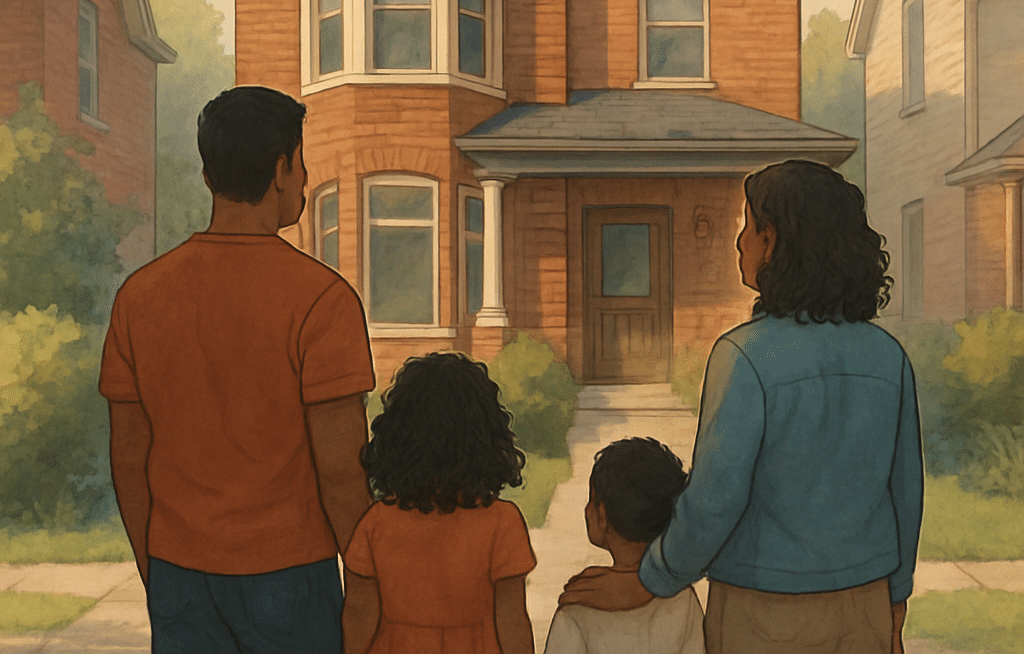In a city known for its energy, culture, and constant motion, the allure of calm, family-friendly quiet streets in Toronto have never been stronger. Across the Greater Toronto Area, families are trading downtown noise and traffic for neighbourhoods where kids can ride their bikes safely, neighbours know each other by name, and evenings end with the sound of laughter instead of sirens.
Welcome to the cul-de-sac lifestyle – a type of community design that’s making a quiet comeback.
Why Quiet Streets Are in Demand
For decades, cul-de-sacs and crescent-shaped streets have been associated with suburban living – the kind of neighbourhoods that grew during the 1980s and 1990s boom in family housing. But today, they’re attracting a new wave of homeowners: younger families, upsizers, and even downsizers who crave quiet streets in Toronto that have both both proximity to the city and a sense of calm.
It’s not just nostalgia. Families are recognizing the tangible benefits of quieter streets – from child safety to community connection.
According to recent market insights buyers are willing to pay up to 20% more for a home on a cul-de-sac due to the peace and privacy it offers. Homes on cul-de-sacs, dead ends, and crescents are often among the first to sell – even when comparable properties nearby linger longer on the market.
It’s more than numbers. The appeal of quiet streets in Toronto is emotional. They offer something increasingly rare: space to slow down.
1. Safety Comes First
Ask any parent what they value most about a cul-de-sac, and they’ll tell you it’s peace of mind. With minimal traffic and slower driving speeds, quiet streets in Toronto are naturally safer for children and pets.
Kids can play street hockey or ride scooters without constant supervision, and parents can chat with neighbours on the driveway instead of worrying about cars zipping by. The design of a cul-de-sac – one entrance, one exit – creates a built-in buffer from congestion and noise.
In neighbourhoods like Amesbury and Bedford Park, quiet side streets have become especially prized by young families. Many of these areas balance suburban safety with easy access to transit and downtown – offering the best of both worlds.
As urban planning experts note, safety and community interaction often go hand-in-hand. When residents feel comfortable letting children play outside, they naturally engage more with their surroundings – creating a stronger sense of place and belonging.
2. A Built-In Sense of Community
Quiet streets in Toronto have a way of turning city neighbours into friends. Cul-de-sacs reduce through-traffic, residents often know one another – and shared routines become part of daily life.
You’ll find families gathering for impromptu driveway barbecues, kids forming friendships that last through high school, and neighbours helping shovel snow or collect mail when someone’s away.
Urban sociologists call this “micro-community living” – a small, stable network that fosters belonging without the anonymity often found in busier urban areas. It’s one reason families who move to quiet streets tend to stay longer.
Many Toronto neighbourhoods – from Chaplin Estates to Wychwood – have cultivated this kind of community identity across quiet streets in Toronto. Parents swap babysitter recommendations, organize Halloween parades, and host summer block parties that turn ordinary streets into gathering places.
For families, these social ties are as valuable as square footage.
3. Space for Growing Families
Quiet streets in Toronto often come with larger lots, mature trees, and room to expand – all major advantages for families thinking long-term.
Detached and semi-detached homes on cul-de-sacs frequently feature private driveways, larger yards, and space for additions or garden suites. These properties offer flexibility – whether that’s a home office, playroom, or a secondary suite for adult children or grandparents.
As Toronto continues to evolve, the city’s official plan even encourages “gentle density” – adding secondary units within existing residential areas to accommodate multi-generational living. Families choosing quiet streets now may find their homes well-positioned for future adaptability, whether it’s building a garden suite or converting a basement into a rental unit.
For buyers, that means investing in a home that’s not only peaceful, but practical.
4. Long-Term Value and Market Stability
Quiet streets in Toronto don’t just feel different – they perform differently in the market.
Real estate data consistently shows that homes on low-traffic streets hold their value better over time. The combination of safety, privacy, and community appeal gives them lasting desirability. Even during slower market cycles, demand for these properties tends to remain steady.
For upsizers in particular, quiet streets offer confidence. You’re not just buying a bigger home – you’re buying into a type of environment that consistently attracts future family buyers.

5. A Different Kind of Daily Rhythm
Beyond the practical benefits, there’s an intangible magic to quiet neighbourhood living. The morning rush feels calmer when you’re backing out of your driveway onto a peaceful street. Evenings stretch a little longer when the noise dies down and you can sit on the porch, listening to crickets instead of traffic.
For families, that slower rhythm makes a big difference. It creates space for connection – not just with each other, but with the community around you.
You’ll see it in small moments: kids playing basketball on the street, parents chatting by the mailbox, or neighbours walking dogs as the sun sets. These are the rhythms that turn a street into a home.
And as many Toronto families are discovering, those rhythms are worth prioritizing.
Where to Find Toronto’s Quiet Streets
Toronto’s geography offers a surprising number of pockets where calm living meets city convenience.
Neighbourhoods like West Hill and Henry Farm feature tree-lined crescents tucked between main arteries, giving families access to everything without the bustle. Both offer quiet, residential pockets where community and convenience meet – with parks, schools, and transit just steps away, yet a sense of calm that feels far removed from the downtown rush.
Each has its own personality – some with older character homes, others with newer builds – but they all share that same defining trait: streets where the loudest sound you’ll hear on a Sunday afternoon is laughter, not traffic.
Bringing It All Together
In a city that never stops moving, quiet streets have become the ultimate luxury. For families, they offer something money can’t buy – peace, safety, and connection.
Whether you’re upsizing, relocating, or simply rethinking what “home” means, exploring quiet streets in Toronto can reveal the kind of lifestyle that feels both grounded and fulfilling.
If you’re ready to find your family’s next home, get in touch with our team for expert guidance. We’ll help you uncover those hidden neighbourhoods and quiet crescents where your family can truly thrive.
Sometimes, the best place to put down roots is the one where the world finally slows down.






